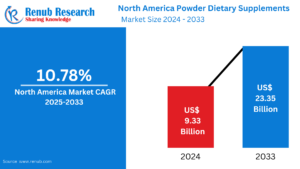Saudi Arabia Poultry Meat Market Size and Share Analysis – Growth Trends and Forecast Report 2025–2033
Market Overview
The Saudi Arabia Poultry Meat Market is expected to reach US$ 5.62 billion by 2033, growing from US$ 4.75 billion in 2024, registering a CAGR of 1.90% during the forecast period (2025–2033). The market’s expansion is driven by rising urbanization, increasing disposable income, and changing dietary preferences toward convenient, high-quality, and halal-certified poultry products. Furthermore, government initiatives supporting domestic production and food security are playing a vital role in transforming the poultry landscape across the Kingdom.
Saudi Arabia Poultry Meat Industry – Key Insights
Dominance in the Region
Saudi Arabia remains the largest poultry meat producer in the Middle East, accounting for approximately 71% of regional output in 2022. Domestic poultry production has seen a remarkable 73.85% increase from 2017 to 2022, with self-sufficiency rising from 45% in 2016 to 68% in 2022.
Urbanization & Lifestyle Changes
The country’s rapidly urbanizing population has led to increased demand for affordable protein sources, with poultry meat becoming a preferred choice over red meat. The expanding retail and foodservice sectors, combined with fast-paced lifestyles, have further fueled demand for processed and ready-to-eat poultry products.
Government-Backed Growth
The Saudi government, under Vision 2030, is aggressively investing in domestic poultry farming through interest-free loans, subsidies, and technological upgrades. These efforts are aimed at doubling production by 2030, while enhancing food security and reducing import dependence.
Market Drivers
1. Government Support & Food Security Goals
Initiatives by the Ministry of Environment, Water and Agriculture (MEWA) and the Saudi Food and Drug Authority (SFDA) are providing up to USD 187 million annually in incentives to stimulate local poultry production. Vision 2030 also permits 100% local ownership for foreign investors in poultry farms, promoting increased domestic participation.
2. Rise of Halal Certification
Halal-certified poultry remains central to consumer preference in Saudi Arabia. Strict adherence to Islamic slaughter and processing standards ensures cultural alignment, enabling trust and loyalty among consumers and expanding opportunities for domestic and export markets.
3. Expanding Retail & Foodservice Infrastructure
The proliferation of supermarkets, hypermarkets, fast-food chains, and online grocery platforms has enhanced poultry meat accessibility. This distribution shift supports broader market penetration, especially in processed categories such as nuggets, sausages, and marinated products.
Related Report
Belgium Chicken/Poultry Market
Market Challenges
1. Intensified Competition & Market Saturation
As domestic production scales up, competition among producers has intensified. The market is witnessing price-based competition, challenging smaller or new entrants. Additionally, low-cost imports from countries like Brazil and Ukraine could potentially undercut domestic offerings.
2. Shift in Consumer Preferences
Growing health consciousness is encouraging a shift towards leaner protein alternatives, including organic poultry and plant-based proteins. Producers must now innovate and diversify their offerings to stay relevant to changing consumer demands.
3. Rising Input Costs
Between 2017 and 2022, poultry prices increased by 7.84%, primarily due to higher imported feed costs and fuel price hikes. For instance, a 1,000g chicken rose in price from USD 3.8 to USD 4 in early 2022. The diesel price surge by 21% following Aramco’s decision also impacted logistics and processing costs.
Key Industry Developments
- MHP SE (Ukraine) partnered with Tanmiah Food Company to scale up local poultry production.
- BRF S.A. (Brazil) launched a joint venture in 2023 to expand its halal-certified poultry operations in Saudi Arabia.
- National Company, Fakeeh, and Almarai collectively contribute over 80% of domestic poultry production.
Market Segmentation
By Type
- Chicken
- Turkey
- Duck
- Other
By Form
- Canned
- Fresh / Chilled
- Frozen
- Processed:
- Deli Meats
- Marinated/Tenders
- Meatballs
- Nuggets
- Sausages
- Other Processed Poultry
By Distribution Channel
- Supermarkets & Hypermarkets
- Convenience Stores
- Online Channels
- Others
Key Players – Company Analysis (4 Key Viewpoints)
Each of the following companies is analyzed based on: Overview, Key Persons, Recent Developments, and Revenue.
- Al-Watania Poultry
- Almarai Food Company
- Almunajem Foods
- Americana Group
- BRF S.A.
- Golden Chicken Farm Factory Company CJSC
- Sunbulah Group
- Tanmiah Food Company
- The Savola Group
Report Details
| Feature | Description |
| Base Year | 2024 |
| Historical Period | 2020 – 2024 |
| Forecast Period | 2025 – 2033 |
| Market Size Unit | US$ Billion |
| Segments Covered | Type, Form, Distribution Channel |
| Customization Scope | 20% Free Customization |
| Post-Sale Support | 1 Year Analyst Support |
| Delivery Format | PDF & Excel (Editable Word/PPT available upon request) |
Key Questions Answered
- What is the projected size of the Saudi Arabia Poultry Meat Market by 2033?
- What is the CAGR for the market during 2025–2033?
- Which poultry type dominates the Saudi market?
- What are the key growth drivers for this market?
- How is the Saudi government supporting local poultry production?
- Why is halal certification critical in the poultry sector?
- What percentage of poultry meat was domestically produced in 2022?
- Which foreign companies have recently invested in the market?
- What are the major challenges, including competition and costs?
- Which distribution channels are most prominent for poultry products?


















